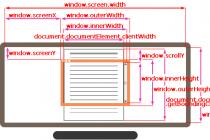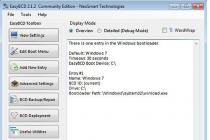There are two functions associated with system images. Firstly, you can create them, and secondly, you can completely restore the system from them.
To create an image, you will have to visit the "File History" section in the Control Panel (Control Panel | File History). Note that it is in the Control Panel, and not in the main Metro-interface "File History Settings" (File History Settings), so be careful when choosing the desired item in the search results on home screen

In the "File History" window that opens, pay attention to the link "Creating a system image" (System Image Backup) in the lower left corner. It opens the familiar "Create a System Image" wizard, in which everything remains the same.

To restore a system from an image - that is, completely return it to a certain state - simply connect external drive The on which the image file is stored. Then go to PC Settings | Update and recovery | Recovery” and click the “Restart Now” button in the “Advanced Startup” item. The computer will restart.
On the Choose an Option screen, select Troubleshoot. In the "Diagnostics" section, select the "Advanced Options" item. On the Advanced Options screen, select System Image Recovery. The computer will restart again.
On the System Image Recovery screen, select your username and enter your password. The Restore System from Image Wizard will start. On the first page select desired image, then click "Next" and follow all the instructions of the wizard to restore the system from the specified image.
Is this the best backup and restore method for Windows 8.1? No. But those who still want to use it can rejoice: it still works. And of course, this is very convenient if you have images lying around. previous versions Windows.
This option will help return the system to a state recorded at a certain point in time - a restore point. If saving such points is configured and enabled, then before installing updates, drivers and applications, the system state will be written to HDD.
Returning Windows to a restore point will save all personal files, but the drivers and applications that appeared after the point was created will need to be reinstalled.
To start Windows Recovery, right-click on the "Start" (Win + X) and go to "Control Panel" → "System and Security" → "System" → "System Protection". Click "Restore" → "Next" and select the desired restore point.
Another path option: "Control Panel" → "All Control Panel Items" → "Recovery" → "Start System Restore".
If the restore point is not found, then system protection is disabled, and you will have to use other methods.
To avoid trouble in the future, enable the creation of restore points. To do this, in the same System Protection menu, select system disk, click Customize, and turn on System Drive Protection.
2. Reset your computer
If there are no restore points or switching to them does not help, try returning the system to the initial state. You can rollback with saving files or completely delete everything and . Also in some computers - more often these are laptops - there is an option to restore factory settings.

In Windows 8 and 10, you can start a factory reset by going to Settings → Update & Security → Reset this PC → Get Started.
In Windows 7, for this you need to go to "Control Panel" → "System and Security" → "Backup and Restore" → "Restore system parameters or computer” → “Advanced recovery methods” → “Return the computer to the factory-set state”.
3. Restore Windows using a disc
The recovery disk is useful, for example, to roll back to a saved point or return to its original state if Windows refuses. An ordinary flash drive, external hard drive or DVD is suitable for the role of such a disk.

The recovery disc must be burned in advance and stored in case of system failure. Under Control Panel → All Control Panel Items → Recovery, click Create Recovery Drive. In the menu that appears, check the “Back up system files to a recovery drive” item, and you can use the USB drive not only to fix errors and roll back, but also to reinstall Windows.
You can create a recovery DVD in Windows under Control Panel → System and Security → Backup and Restore → Create a System Repair Disc. The same method works in newer versions of the system, only the name is different: "Backup and Restore (Windows 7)" instead of "Backup and Restore".

To correct errors, boot the system from disk. In the recovery environment that opens, click Troubleshoot. Start Reverting to a System Restore Point in the Advanced Options → System Restore menu.
4. Restore Windows using a full system image
Another option for restoring Windows is to roll back to a previously created system image. The image is written to a hard drive, to DVDs, or to a network partition.
Unlike a rollback or restore from a point, using a full image retains all files, applications, settings, and drivers installed at the time it was created.

The most opportune moment to create such an image may be when everything is installed on the system and desired applications, but there is nothing superfluous. So you can continue working immediately after recovery.
To create a complete system image, in the Control Panel, select "Backup and Restore (Windows 7)" → "Create a System Image". (In Windows 7: Control Panel → System and Security → Backup and Restore → Create a System Image.)
In the menu that appears, you can choose which of the available partitions and files to include in the system image and what media to write it to.

With a complete system image at your disposal, you can quickly return Windows to the state you need. You can start image-based recovery when you restart your computer: "Diagnostics" → "Advanced Options" → "System Image Recovery".
Windows 8 System Restore may be required when you encounter critical errors in PC operation. So that the user does not have to completely reinstall the OS, special tools are provided that allow you to restore the computer even without deleting files and changing general parameters systems. In this article, you will learn how to start recovery of a computer or laptop on Win 8 in different ways.
Below are two scenarios for the development of events: with a working operating system and with a faulty one. In the first case, you can restore from the Windows 8 interface without a disk or flash drive, and in the second, you will need bootable media to copy system files. All methods are shown below:
- rollback from a restore point;
- using Refresh your PC;
- reset to factory settings on a laptop;
- recovery with boot disk or flash drives.
Let's consider each of the methods in detail. All instructions are fully working and suitable for any Windows builds 8 32/64 Bit.
System restore point
This method allows you to roll back the OS to a certain state. You must do the following:
- Open File Explorer using the icon on the taskbar.
- In the left directory, find the item "This PC" and right-click on it to select "Properties" from the menu.
- In the window that opens, click on the "System Protection" button.
- In the selected tab, click on the "Restore" button.
- On the first screen, click on "Next".
- From the list, select a checkpoint according to the date when the state of the computer was stable and working. Click Next.
- To start the procedure, click the "Finish" button.
Now you know how to use a checkpoint to roll back the OS state.
Create a checkpoint
If you don't have checkpoints set up automatically, you can do it manually. This option is useful in case of problems with the OS in the future:
- Open the Properties window again and click on System Protection.
- Next, click on the "Create" button marked in the screenshot.
- Enter a name and click Create.
- Wait until the end of the procedure. After it, the current OS configuration will be saved as a checkpoint. You can easily restore this state in the event of a Windows 8 malfunction using the above instructions.
Rollback through "Options"
Windows 8 first introduced the Refresh Your PC tool. With it, the user can roll back the state of the OS to the required one. You can save applications and settings, reset your PC to factory settings, completely reinstall the system, or launch a safe environment and perform the necessary actions through it.
First you need to open "Computer Settings":
- Right-click on the "Start" icon and select "Find".
- In the search bar, enter the query "computer settings" and open the appropriate application.
- In the list of partitions, select Update and Recovery.
- Go to the "Recovery" subsection. Here are tools that allow you to restore the original state of the OS or start safe mode.
The first option (1) allows you to restore the factory Windows settings 8 without losing personal files, music, photos, etc. Using the second item (2), you can call up a menu for completely reinstalling the OS and returning it to the factory preset settings. However, all personal files and installed applications will be removed. By clicking on the button in the third paragraph (3), you can call up a safe environment and continue settings through it. The first two options allow you to roll back the system from under the Windows 8 interface.
It is worth dwelling on the secure environment in more detail, since advanced functionality awaits you there.
Click on the "Restart now" button and wait - on the screen you will see how the menu starts with the choice of action. Click on Diagnostics.
As you can see, here you can perform all the same operations as in the Windows 8 interface. However, the diagnostic menu can come in handy if the OS does not boot. Click on the "Advanced options" button to go to advanced functionality. With it, you can:
- roll back the OS to a checkpoint;
- use a wim image for recovery;
- roll back the system through the command line.
Let's consider all the possibilities in more detail. We dealt with the first point above - the procedure is no different from performing in running Windows 8.
By clicking on "System Image Recovery", you launch a program to automatically unpack a pre-created wim archive. It should contain the entire OS with personal settings and programs. You can connect a disk or flash drive to your computer to unpack a third-party wim image. This way you get a complete system.
"Command line" allows you to run the rollback procedure using simple commands. Click on the appropriate button to launch the application. Now enter the command "rstrui.exe" and press Enter to run. After that, you will get access to the menu with restoring the PC through the checkpoint.
You can launch this menu through bootable media if the installed OS does not work correctly and does not start. Let's consider such a situation.
Performing the procedure using a flash drive
To perform the procedure in this way will require some preparation. First, you need to create bootable media. To do this, you need to visit the official Microsoft website, where the Windows 8 web installer is located and download it to another computer. The bootloader will download the OS files and create boot drive automatically.
Secondly, you need to make settings through the BIOS. To do this, when starting the PC, press the button responsible for entering the BIOS menu (it is indicated on the initial screen of turning on the computer). Go to the Boot menu and install bootable flash drive in first place in the download priority. To save the settings, press F10 and restart the PC again.
Now, when you turn it on, you will see the installer menu. Here you will find the possibility of uninstalling, reinstalling the system, formatting hard drive. The creators also highlighted the recovery function in a separate menu:
- Select the desired item and start the procedure.
Rollback on a laptop with a preinstalled operating system
Notebook manufacturers that sell devices with pre-installed software provide the ability to roll back using proprietary utilities and tools. Part of the hard drive space is allocated for recovery, so you can start the procedure for returning the PC to its original settings in a couple of steps.
It refers to Asus laptops, Lenovo, Acer, HP and more. Consider the procedure on the example of Acer Iconia tab w5100. By default, this company uses the keyboard shortcut Alt + F10 , which must be pressed on the initial boot screen with the Acer logo.
You will see the "Acer eRecovery Management" menu. Select the marked item.
After that, wait until the end of the procedure. During the process, the laptop may restart several times. You can cancel the recovery process only by restarting the PC. After the end of the rollback, you will receive a device with factory settings.
The names of the utilities and how to access them differ depending on the manufacturer of the laptop, but using this example, you can easily restore Windows 8 on any device.
Conclusion
Using the described methods, you can return the working or original state of Windows 8 in almost any situation. Use checkpoints to restore your computer to its previous state. The Refresh Your PC functionality is useful when you roll back your PC to factory settings. A safe environment is useful if Windows 8 does not start - the necessary tools can be opened through a bootable USB flash drive.
Video
Below you can watch a training video that clearly shows all the steps in this article. Together with the video instruction, you will be able to understand the difficulties and restore your computer without outside help.
In Windows 8.1 (at least in the currently officially available Windows distribution 8.1 Preview) Microsoft decided to abandon the graphical wizard left over from the days of Windows 7 Reserve copy system image (Windows 7 backup tool).
In the recently leaked Windows 8.1 RTM network, a graphical wizard for creating a system image still appeared. Details at the end of the article.
Naturally, this does not mean that in Windows 8.1 it is impossible regular means create backup system image backup (do not confuse system image backup and File History backup technology for user data), it's just that now this functionality has been transferred to a separate Wbadmin command line utility and is not available from the GUI. In this article, we will talk about the features of using the Wbadmin utility to create a backup copy of a Windows 8.1 image and then restore the system from this image.
Backing up the Windows 8.1 image
Image operating system takes up a lot of disk space, so to perform the operation, you must have enough free space (no less than the size of the occupied space on the system disk) on some external disk (for example, USB connection) or network directory.
Open an elevated command prompt and run the following command:
wbAdmin start backup –backupTarget:H: -include:C: -allCritical –quiet
where H: is the external drive on which the system image is saved
C: - the drive whose image must be forcibly added to the backup being created
AllCritical - very important parameter, indicating that all critical sections of the system must be included in the backup, i.e. sections containing any system files or components (including the hidden boot partition).
Quiet - when executing a command, do not ask the user for confirmation
In the event that it is necessary to include several disk partitions in the backup (for example, C:\, E:\ and F:\), the command will look like this:
wbAdmin start backup -backupTarget:H: -include:C:,E:,F: -allCritical –quiet
If the backup needs to be written to a shared network folder:
wbAdmin start backup -backupTarget:\\srv-bak1\BackupFolder -user:username -password:userPassword -include:C: -allCritical -quiet
Note: if authorization is required to access the network folder, please specify the username and password
Depending on the number of disks, how full they are, and the performance of your computer, the process of creating a system image may take several hours (depending on this example, with 40 GB of information on the C:\ drive, the system backup took about 2 hours).

If, after the backup has been created, you open the drive (or network directory) to which it was written in Explorer, you can find the WindowsImageBackup directory familiar from the days of Windows 7 (Backup and Restore function) with several .xml and .vhdx files in it. These are files with system partition images and configuration information.

Advice. In the event that only a few directories or files need to be restored from the created image, we recommend that you read the article: How to restore individual files from a Windows 8 image
How to restore Windows 8.1 from an image
Next, let's try to figure out how you can restore Windows 8.1 from an image with a backup on an external drive.
Attention: When restoring from a backup, all data on the restored partition will be deleted and replaced with the data contained in the backup.
Boot from boot or installation disk Windows 8.1, connect the external drive you previously burned to backup image systems.
After starting the installation wizard, click on the Repair your computer link (in the lower left corner)

Then go to Troubleshoot -> Advanced Options -> System Image Recovery

Next, select the OS you want to restore. The system should automatically find the previously created Windows image backup on the external drive (if it doesn't, you'll have to specify it manually).

And finally, by clicking the Finish button, start the process of restoring the system from the image.

System Image Backup in Windows 8.1
Update dated 09/06/2013. After getting acquainted with the recently "leaked" Windows 8.1 RTM (build 9471), we managed to find out that Microsoft decided to return GUI control over the creation of a backup copy of the entire contents of the computer. This function called System Image Backup. To create a full system image in Windows 8.1 (including EFI system partitions, boot, etc.):
Open Control Panel and go to System and Security > File History.
Click the "System Image Backup" button in the lower left corner
Select a drive or network folder on which the system image will be "folded"

Then you need to select the partitions that you want to include in the backup (system partitions are always selected by default).

Click Next, after which the system will start writing its image to an external drive or network directory.
Due to the presence of viruses, mismatched drivers or software, the OS may fail. If your Windows crashes, don't panic. The situation can be corrected by returning the state of files and programs to the moment when the PC was working properly.
While running OS Windows 7, 10 or 8, certain errors and problems may occur. As a result of such failures, a new launch of the operating system in operating mode becomes impossible. In this case, it is not at all necessary to do a laborious reinstallation of the OS. It is enough to perform a system restore.
OS recovery using the recovery environment
At work, we use the following scheme of actions:
- Reboot the computer, press the F8 key during boot;
- Troubleshooting;
- System restore, OS restore point selection;
- click "Further" and again "Further";
- We press the button "Ready", reboot the system (in the Menu, select boot with the last known good configuration).
There are several ways that you can resort to resuming the operation of the OS. Some of them are based on reverting to saved settings. Others simply clear the data.
You can perform "resuscitation" of the OS in one of the following ways:
- by selecting restore points;
- using the command line;
- through safe mode;
- using the recovery environment;
- using an image/boot disk.
Restoring the operating system using system "resuscitation" checkpoints is one of the most affordable, effective and popular options. To apply it, you need to make a series of clicks:
- Panel "Start";
- "System Restore";
- "Further";
- "Select a restore point";
- "Ready".
This operation will fix the problems with the computer, undo the changes and return the system to a working state that allowed the PC to boot normally. Loss of data, files and documents does not occur during such recovery. All data is saved. The operation is reversible. You can roll back the system to a previous state of the computer and use a different restore point.
Many people ask themselves how to make a recovery point on their own (manually) in order to choose it in the future? To do this, in the same menu "Start" - "System Restore" You can create such a point yourself at any convenient and suitable time for you. It will be saved with the current date, which can only be remembered.
From a restore point
In computer engineering, there is such a thing as a restore point. These are saved PC settings. As a rule, saving occurs automatically with each successful OS boot. The easiest way to resume Windows 7 is to use exactly this data.
Press F8 when the computer boots up. This command will bring up a menu of system startup options. Next, select the Last Known Good Configuration option.
You can also use another method. Enter the properties of the My Computer folder. Find the System protection line, clicking on which you will open the dialog box of the same name. Click Recovery - Next. We set a key date, indicate the disks that are subject to correction, and confirm the actions. After rebooting, the PC should work normally.
No restore points
You can fix OS problems without having restore points. To do this, you will need to resort to the LiveCD program. It needs to be downloaded and written to a USB flash drive with the .iso extension.
Further, all actions will take place in the BIOS. You need to configure boot from a flash drive. To do this, in the Boot section, select USB-HDD in the First boot device line.
Before proceeding directly to recovery, copy all required files to a removable disk. The LiveCD program provides a special menu for these purposes.
We will fix system error using a backup copy. Connect the flash drive, open the folder Windows\System32\config\ . Files with the names default, sam, security, software, system must be moved to any other folder. In their place, we transfer similar files from the RegBack folder and restart the computer.

The described method will only help if the problem is related to the registry.
Command line
You can resort to "reviving" Windows 7 from the command line if the PC begins to freeze or work slowly, however, the system boots up. Enter the menu "Start" and using the right mouse button, launch the command prompt as an administrator. Issue the rstrui.exe command, which will open the System Restore program. Click "Further". In the next window, select the desired rollback point and click again "Further". Upon completion of the process, the PC should work normally.
You can enter the utility in another way. We go to "Start". To call the command line, press "Run" and write the CMD command. We click on the found file CMD.exe and wait for the launch. Next, enter in command line rstrui.exe and confirm the action with the Enter key on the keyboard.
It is not always possible to play it safe and create OS restore points in advance. There may be problems that block the option of such a "resuscitation" of the PC. Then you can use another, no less effective and easy option - restoring the Windows system using the system itself.
Based on the diagram:
- Icon "My computer"- right mouse button "Properties";
- "System Protection";
- In a new window, click "System Protection", restore button;
- "Further";
- Choose a restore point according to the date;
- Specify the system disks to be restored;
- Confirm the operations and reboot the system.
Restoring Windows 7 using Safe Mode
This method is preferred if the usual system boot is not possible. Then after pressing the power button on the PC on system block hold down the F8 key to call "Launch Menu". One of the menu options is « Safe mode» . Select it and press Enter on the keyboard. As soon as Windows loads, we perform the algorithm of actions that we described earlier.

System Restore Windows 8/8.1
If you were able to start the OS, you can resume Windows 8 via "Options". Hover over right top corner and enter them. Click on "Changing computer settings" – . Chapter "Recovery" will offer several options:
- "Typical Restore with Information Preservation".
- "Delete data and reinstall OS".
- "Special Option".
Decide exactly what needs to be done. Then follow the menu prompts.
If you choose the latter method, in the window that opens, click on the diagnostic item. You will be offered the following options:
- "Reestablish";
- "Return to original state";
- "Extra options". This item includes the ability to roll back to the desired resume point.

To resume Windows 8.1 press Win+R and call sysdm.cpl . In the system properties window, on the tab "Protection" specify the required system drive. Click "Reestablish". Clicking "Further", you will be able to see a list of rollback points. Select the one you want and click "Search for affected programs". Changes that have been made to the PC since the selected moment will be deleted. End the process by clicking "Ready".
If you are using Windows 8, you may encounter problems incorrect work the Internet, etc. To fix this, you can use the classic recovery method through restore points.
Another option is to roll back the system. To do this, open the menu "Start" - "Control Panel" - "Centre Windows updates» . Choose an item "Uninstall updates". You can do the same using the command line.
So, in the list of updates that opens, we remove those of them, from the moment of installation of which (we look at the date) problems and malfunctions began. Delete junk files and do a reboot.
In Windows 8.1, you can perform a factory reset. Important files will not be affected during this operation. The method is effective, but for its implementation, the OS needs to boot without any problems. We use the algorithm:
- Right side of the monitor - "Options";
- "Change settings";
- "Renewal and Recovery" - "Recovery";
- "Recovery without deleting files".
If you cannot log into the system in the usual way, you must use the disk with the system. Load the installation disk, select "System Restore". We press the button "Diagnostics", and "Reestablish".
If you're having problems with Windows 10, press Windows + Pause. Go to "System Protection" and press "Reestablish" – "Further". Select the desired indicator and click again "Further". When finished, press "Ready". The computer will automatically restart and the changes will take effect.

One of the advantages of the "dozens" is the ability to return the settings to the factory settings. This helps avoid having to install the system first. To reset your data go to "Computer Settings" – "Update and Security" – "Recovery" – "Reset your computer". Click "To begin".
You can take care of the possibility of rollback in case of failure in advance. Resume points can be created manually or configured to be automatically created at the desired frequency. To do this, in the settings, in the Update and security item, select the Backup service. Specify where to save copies, click Add disk. After selecting a device, the function will be activated.
You can restore the Windows 10 system again through the use of restore points. In this case, the system will be rolled back to the moment when it was freely loaded and worked without failures. This recovery method is described at the beginning of the article.
If the OS is not loaded, then a warning table appears on the screen with the key "Additional recovery options". Click it and choose "Diagnostics" - "System Restore". We make a choice of a Windows restore checkpoint, we are waiting for a system rollback and reboot.
If these operations did not help and the computer continues to work incorrectly, you can roll back to basic settings. Some programs and utilities, personal PC settings will be reset, and personal data will be deleted.
This technique is used extremely rarely if the other options described above do not help. The algorithm of actions in this case is as follows:
- "Start" - "Setting options"- tab "Updates and Security";
- Paragraph "Recovery"- button "To begin";
- Choose to delete all files or save some of them.
The system rollback after that will take 40-90 minutes.
Resume using the installation disc
One of the radical methods of fixing the error involves using the installation disk. After running it in BIOS, click System Restore. In the Troubleshooting section, select the desired action. Then follow the system prompts to complete the process.














